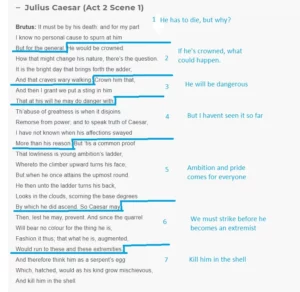
How to Memorise a Monologue
The first question every actor gets asked by well-meaning family members following a performance is: “How did you learn all of those lines?!” It’s not their fault, it’s the rules. The question comes from a common, kind-hearted-yet-misguided perception that the learning of the words is the hardest part (where, in actual fact, it’s the anxiety of performance and the fear of vulnerability that really cooks your noodle.) Today, though, I am going to lay out a few ways of learning those pesky monologues. And the next time some innocent Aunt or Uncle presses you for your technique, you can forward them this article and tell them to have a read! Additionally, if you are trying to memorise a monologue and struggling with the process, this article will be useful for you as well.
The best way to memorise a monologue is to figure out the process that works best for you, break the monologue down into smaller chunks and learn it methodically, part by part, until you can re-assemble and repeat it verbatim. There are three primary modes of learning: auditory, visual and kinaesthetic. Knowing which ones suit you best and then tailoring a line-learning method to suit will hugely benefit you in the monologue learning process.
Let’s get into it!
Break it Down into Beats
Next to how to film a self tape, our most discussed topic on StageMilk is probably what are beats? Beats are the basic chunks of a monologue/scene/story, that denote a shift in the scene either in what the character’s objective is, or how they decide to achieve their goal (via actions). They’re usually denoted by a shift in emotion, a piece of information learned or given or a similar moment of dramatic action within the story.
Beats are a vital part of script analysis and the foundation of breaking down a script into smaller, workable chunks. The articles linked above are super useful resources on this subject, and you should read them as they speak on the topic in greater detail.
Essentially, the first part of learning your monologue is to spit it up into its key ideas—its beats. By breaking it down into its beats, we make the monologue more manageable, and easier to navigate. Plenty of actors find themselves overwhelmed by the whole monologue, and the thought of having to learn an intimidating wall of text. By breaking it up into beats we can learn it idea by idea, thought by thought and make it more manageable for ourselves at the same time.
In that beats article linked above, I use a monologue from Julius Ceasar as an example. take a look below:
As you can see, I have named each beat—given it a theme, so to speak, as well as numbered it. This helps me have an idea of what the tone of the thought is behind the beat, and helps clarify the structure of the piece as well.
In this monologue, Brutus starts off knowing he has to kill Caesar, but not having the proper motive to murder his friend. Over the course of the piece, he convinces himself that it would be for the greater good to stop Caesar before he becomes a danger. By breaking it up into smaller, more manageable chunks, I can understand the character’s thought process easier and see how he changes from one point of view to something else by the end.
How do you Learn?
When it comes to learning, there are countless methods you can adopt to help you in the education process. In my experience as an actor and educator, I subscribe to the VAK idea of education. Visual, auditory and kinaesthetic.
Visual learners learn by seeing. Artists, designers, people with detailed memory or recall for complex visual situations enjoy using graphs, maps and diagrams, love colour coded flashcards or mind maps and so on.
Auditory learners learn best by hearing things. If you’re a musician, or you can quote whole episodes of television or movies verbatim, or recall big passages of podcasts or speeches from memory, chances are you are an auditory learner.
Finally, kinaesthetic learners learn by doing. Commonly dancers, physical theatre practitioners and sports people learn best by doing with their bodies. They can find themselves restless and fidgety in traditional academic contexts, and potentially struggle with more abstract conceptual topics.
Generally, people are have a primary category they align with best and a secondary category that is kinda helpful. For me, my primary is auditory: I can remember whole swathes of movies, TV shows and songs. I can quote stuff that I have heard only once or twice pretty well from memory, and this gives me a huge advantage with line learning. It also means that I need to build my line learning process around hearing the words and their meaning.
My secondary category is kinaesthetic. I play a few sports, and learned guitar mainly from finger positions rather than musical notation. I have found, purely by trial and error, that if I need I can use movement to help the lines get into my body. I have also found that I struggle with assessing and understanding visual elements, like reading a script and picturing what it looks like on the screen.
You might be like me, or you might be massively visual! It’s all good! Everyone is different, so I am going to give you my best memorisation tactics for each type of VAK learning.
Learning your Monologue
Visual Learners
The very best way I have seen for visual learners to get their lines down is Andy’s method, seen here, in How to Learn Lines FAST:
Grab a pad and a pen and write out the monologue, beat by beat, noting down the first letter of each word in a sentence with the exact punctuation. Then, using that as a reference, repeat the sentence back using just the letters on the page. Once you’ve done one sentence and can recall it without looking at the page, move onto the next until you have learnt the whole beat. Once you have that beat, start on the next, and rinse and repeat. Magic!
If you struggle with a particular word or idea, you can draw little symbols or doodles to really push that particular blank home. Anything to make it visual and fun for yourself! Just remember that the letters and punctuation need to be exact.
Auditory Learners
The temptation for auditory learners is to record the monologue and listen to it over and over until you remember it. While this seems like a logical process, I would actually advise against it. It’s too easy a way to ingrain a mode of delivery; you’re inclined to repeat the monologue exactly as first recorded, which stops you from taking direction. It’s especially constricting in a scene when another actor is present, as you can’t be sure of what they’ll bring to the scene that might modify your delivery (remember that a monologue is still about communicating with your scene partner—even if you’re doing all the talking.)
My recommendation is to do an exercise known as “The Whats.”
Go through your monologue, sentence by sentence, and define what every word means—either what the word literally means or what it means to my character.
For example:
Shall I compare thee to a summers day?
If I was learning that, I might say to myself out loud:
“Could I: me, Romeo, compare: make a comparison between, thee: you, Juliet, love of my life (insert image of actual person who is that for you in reality), towards, a bright, warm 24- hour period in January?”
This can take a long time, depending on the script! But it really does help you learn the lines AND the thoughts behind them. If you drop a word, instead of getting stuck you will subconsciously add in a similar word and keep the moment going.
By saying the words out loud, it means you hear them and think about their meaning, context and subtext. It keeps your work fresh and doesn’t lock you into a single mode of performance.
Kinaesthetic Learners
My kinaesthetic friends! You have got to move it! I find the best way to learn as a kinaesthetic learner is to assign each word in the sentence a gesture, and dance it out!
Make sure you use your full body and repeat the same gestures for the same words. I find this works really well in conjunction with “The Whats” exercise above. Combining multiple styles can really help get the words into your body, so give it a go next time you are memorising!
The Pitfalls
There are two big pitfalls when it comes to learning lines, particularly when you’re learning monologues.
The first is learning by rote. The problem with repeating sentences over and over is they start to become meaningless—just noises you’re making in a particular order. It can also mean that if you drop a word, you go totally dry (a fear worse than death for me!)
The second pitfall is locking in choices early and then lacking flexibility. When you go for an audition, the director might have a totally different idea of the piece to how you have practiced it; you need to be flexible and able to play with the text! If you have learned it by rote, or from a recording, it is very unlikely that you will have the ability to play with it.
Instead, when you are learning your lines, try to learn them neutrally: not putting too much emphasis on particular words or adding too much emotion. Get completely off book first, then look for that emotional arc. Add in those images, invest in the given circumstances and so on! If you do this while you are trying to learn it, and commit fully every time in the same way, the piece will become predictable and feel wooden and rehearsed. Learn it first, then add in your emotional and imaginative flair!
Conclusion
There you have it: how to memorise a monologue! Once you have picked one out, (its own challenge, see here for tips), break it down into manageable beats, pick a learning style that resonates with you and start at the very beginning. It’s a very good place to start. By making it manageable for yourself, keeping emotion out of it and really utilising the way you learn best, you will find that you can get your next monologue down in record time!


Leave a Reply